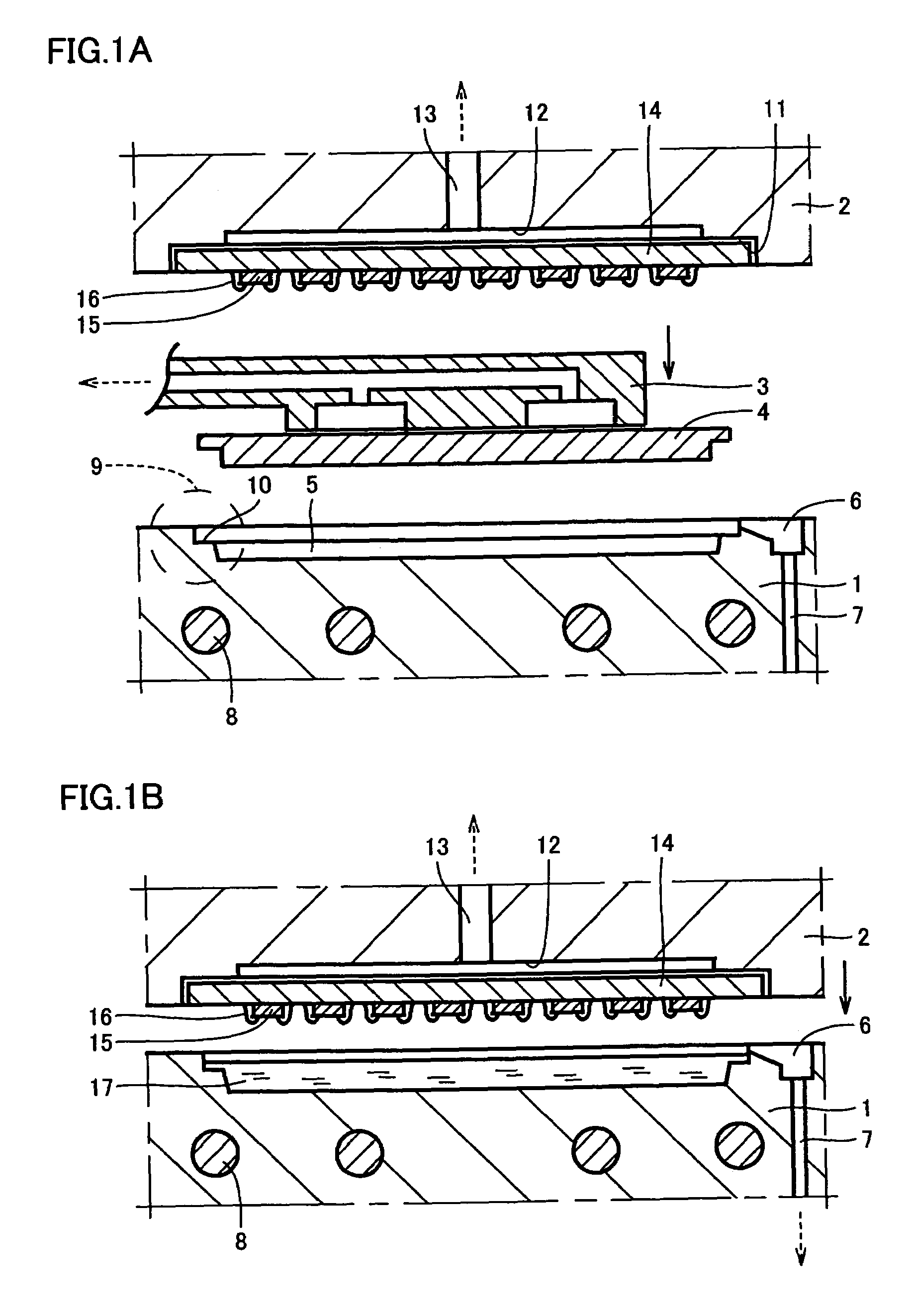Method of resin encapsulation, apparatus for resin encapsulation, method of manufacturing semiconductor device, semiconductor device and resin material
a technology of resin encapsulation and resin material, which is applied in the direction of semiconductor devices, semiconductor/solid-state device details, coatings, etc., can solve the problems of high viscosity, difficult for the gas in the melted resin to escape to the outside, and the speed of melted resin introduction, so as to reduce the possibility of generating defective resin mold products and efficiently use resin materials.
- Summary
- Abstract
- Description
- Claims
- Application Information
AI Technical Summary
Benefits of technology
Problems solved by technology
Method used
Image
Examples
first embodiment
[0041]Referring to FIGS. 1A to 3B, the method of resin encapsulation in accordance with the first embodiment will be described.
[0042]As can be seen from FIGS. 1A and 1B, in the resin encapsulating apparatus used for the method of resin encapsulation of the present embodiment, a mold pair is provided that has a lower mold 1 and an upper mold 2 opposing to each other. Further, the resin encapsulating apparatus is further provided with press means (not shown) for opening and closing lower mold 1 and upper mold 2.
[0043]Further, FIG. 1A shows a conveyer unit 3 positioned in a space between lower mold 1 and upper mold 2. By the function of a driving mechanism, not shown, conveyer unit 3 can be inserted to the space between lower mold 1 and upper mold 2, and also by the function of the driving mechanism, conveyer unit 3 can be moved from the space between lower mold 1 and upper mold 2 to the outside of the space. A resin material in the form of a plate is fixed to conveyer unit 3 by adsorp...
second embodiment
[0063]Next, the method of resin encapsulation in accordance with the second embodiment will be described with reference to FIGS. 4A to 5B. FIGS. 4A to 5B show the structure of the resin encapsulating apparatus in accordance with the present embodiment. In each of FIGS. 4A to 5B, portions denoted by the same names as the components of the resin encapsulating apparatus in accordance with the first embodiment described with reference to FIGS. 1A to 3B have the same functions as in the first embodiment, and therefore, description thereof will not be repeated.
[0064]Referring to FIGS. 4A to 5B, in the resin encapsulating apparatus in accordance with the present embodiment, board 14 is placed on lower mold 21. On board 14, resin material 22 is placed. Resin material 22 has such size and shape that correspond to the size and shape of a cavity (which will be described later) formed in upper mold 25. Resin material 22 has a flat portion 23 and edge portions 24. As can be seen from FIGS. 4A an...
PUM
| Property | Measurement | Unit |
|---|---|---|
| conductive | aaaaa | aaaaa |
| size | aaaaa | aaaaa |
| time | aaaaa | aaaaa |
Abstract
Description
Claims
Application Information
 Login to View More
Login to View More - R&D
- Intellectual Property
- Life Sciences
- Materials
- Tech Scout
- Unparalleled Data Quality
- Higher Quality Content
- 60% Fewer Hallucinations
Browse by: Latest US Patents, China's latest patents, Technical Efficacy Thesaurus, Application Domain, Technology Topic, Popular Technical Reports.
© 2025 PatSnap. All rights reserved.Legal|Privacy policy|Modern Slavery Act Transparency Statement|Sitemap|About US| Contact US: help@patsnap.com



